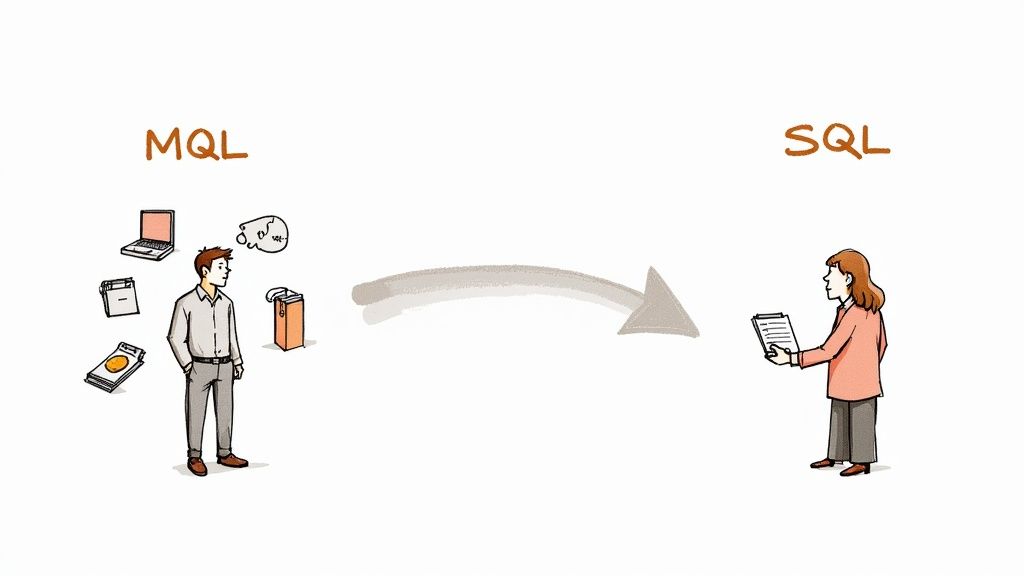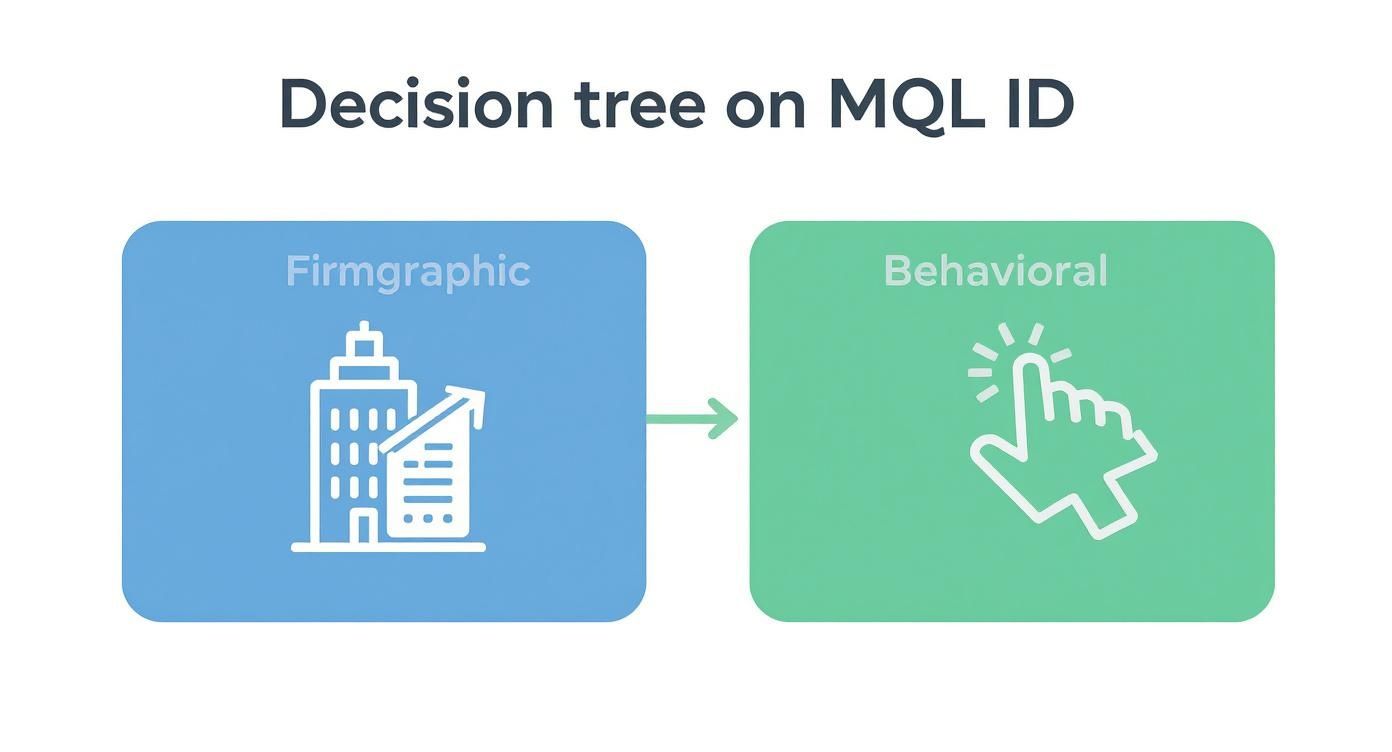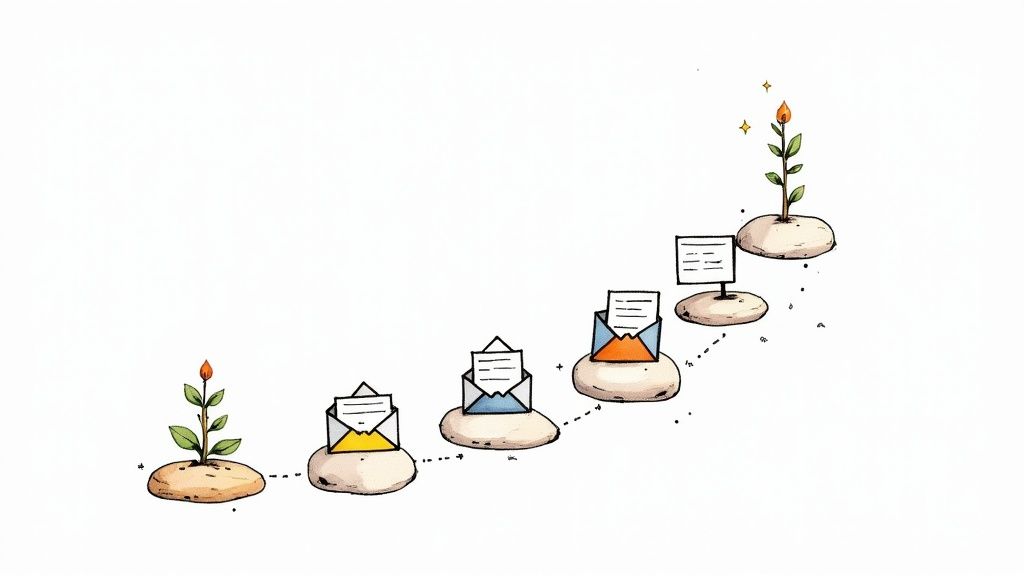
How to Improve Customer Engagement for SMBs
Discover how to improve customer engagement with practical strategies. Learn to personalize experiences, use AI, and build lasting customer loyalty.

So, what exactly is a Marketing Qualified Lead (MQL)? Think of it as a prospect who has raised their hand, showing they’re more than just a casual browser. They've interacted with your marketing materials in a way that signals they might just become a customer down the road.
These aren't just random names on a list; they are specific people your marketing team has flagged as being a good potential fit.

Let's use a real-world analogy. Imagine someone walks into your brick-and-mortar store. They aren't just window shopping. They're picking up products, reading the labels, and maybe even asking an employee a question. That person is showing clear buying signals.
An MQL is the digital equivalent of that shopper. They've taken specific actions—like downloading a guide or signing up for a webinar—that tell you they’re genuinely curious about what you offer. It’s less about just collecting email addresses and more about spotting the people who are starting to view your company as a real solution to their problem.
The MQL is the crucial handoff point between your marketing and sales teams. They represent the moment a prospect moves from the "just looking" phase into the "hmm, this is interesting" category.
Here’s a simple way to break it down:
A Marketing Qualified Lead is someone who looks like a good fit for your business and has shown enough interest to be considered a viable prospect, but they still need a bit more nurturing before they're ready to talk to sales.
MQLs have been a cornerstone of B2B marketing for years. The average organization generates around 1,877 leads per month, with a significant portion often classified as MQLs. If you're curious how this fits into the bigger picture, check out our guide on demand generation vs lead generation. This number underscores just how central MQLs are to turning marketing efforts into sales opportunities. For more stats, Exploding Topics has some fascinating lead generation benchmarks.

The journey from a curious visitor to a loyal customer has a crucial pivot point: the moment marketing hands a lead over to sales. This is where the difference between a Marketing Qualified Lead (MQL) and a Sales Qualified Lead (SQL) really matters. Getting this handoff right can make or break your growth.
Think of it like dating. An MQL is someone who agreed to a first coffee date—they're interested and want to learn more. An SQL is the person asking for a second date and talking about future plans, showing they're serious and ready to take the next step.
The real split between these two lead types comes down to their mindset. An MQL shows interest in what you do, while an SQL signals a clear intent to make a purchase. Marketing's job is to nurture that initial curiosity until their behavior shows they're not just browsing anymore. Once a lead moves beyond general research and takes actions that scream "I'm ready to talk," it's time for sales to step in.
This shift is usually marked by very specific, high-value actions:
The handoff from MQL to SQL isn't just another box to check. It's the moment a prospect's engagement signals they're ready for a real sales conversation. Hand them off too soon, and you seem pushy. Wait too long, and you might lose them to a competitor.
This table breaks down the fundamental differences between Marketing Qualified Leads and Sales Qualified Leads across key attributes.
A smooth, clearly defined handoff process is what keeps good leads from falling through the cracks. It’s absolutely essential for both your sales and marketing teams to agree on the exact criteria that turn an MQL into an SQL. When everyone is aligned, the entire process becomes far more efficient.
Figuring out which leads are truly ready for your sales team isn't a guessing game. It's a methodical process that relies on a smart system for flagging your best prospects based on the data they give you. Think of it like a detective building a case. You need to look at two kinds of evidence: the suspect's background (who they are) and their recent activities (what they’ve been doing).
The first piece of the puzzle is firmographic data. This is all the factual information about a lead and their company. It tells you if they fit the basic mold of your ideal customer. If you haven't already, mapping out how to create buyer personas is a fantastic place to start. https://brandboosteraa.webflow.io/blog/how-to-create-buyer-personas
The other half is behavioral data. This is their digital body language—the actions they take that show how interested they are in making a purchase.
Here’s a simple way to look at how these two data types come together:
Firmographic Data (The "Who"): This is about their profile.
Behavioral Data (The "What"): This is all about their actions.
The magic happens right at the intersection of a great fit (firmographics) and high interest (behaviors). A lead who perfectly matches your ideal customer profile and is actively digging into your solution is the one you want.
To make this system work, you give points for different attributes and actions. A "Director" title might be worth 10 points, and a visit to your pricing page could add another 15. Once a lead’s score hits a certain number, they officially become an MQL. To get this right, you first need to know how to generate B2B leads that convert by having a laser-focused Ideal Customer Profile.
Let's talk about the elephant in the room. Your marketing team is crushing its MQL goals, but the sales numbers aren't moving. What gives? It’s a frustratingly common scenario, and it almost always points back to a few fundamental problems in the lead qualification process.
The biggest culprit is often a definition of "qualified" that's just too generous. If your system treats someone who downloaded an introductory ebook the same as someone who requested a pricing demo, you're setting yourself up for failure. This inflates your MQL count, but it clogs the pipeline with people who are just kicking the tires.
Another massive leak in the funnel is the classic disconnect between marketing and sales. When marketing hands over a lead before they're truly ready, the sales team ends up wasting valuable time on conversations that go nowhere. Worse, it can annoy the prospect and sour them on your brand.
Context is everything. A sales rep can't have a meaningful conversation without knowing the why behind the qualification. What pages did they look at? What specific pain points did the content they downloaded address? Without that story, even a promising lead can fall flat.

As you can see, a lead only becomes truly qualified when they check both boxes: they fit your ideal customer profile and they're actively showing buying intent. It’s never been about the sheer volume of MQLs; it's always about the quality and readiness of each one.
The reality is that a huge number of leads never advance. A staggering 80% often go unpursued or don't match a buyer's immediate need.
This gap highlights just how expensive a broken MQL process can be. If you want to dig deeper into this challenge, you can find more helpful lead generation statistics over at inbeat.agency.

So, you've identified an MQL. Great! But the real work is just getting started. Now it’s all about nurturing that lead—building trust and gently guiding them toward a sales conversation without coming on too strong. The aim here is to provide genuine value, not just a premature sales pitch. Think of it like you're handing them a map instead of trying to grab the steering wheel.
The absolute best way to nurture a lead is to educate them. Ditch the generic sales messages and instead, send them content that speaks directly to the problems they're facing. Show them, don't just tell them, how you can help. Relevance is everything.
Here are a few powerful ways to do just that:
Nurturing is the critical bridge that turns lukewarm interest into genuine excitement. Effective nurturing ensures that by the time an MQL talks to sales, they are already convinced of your value and are eager to learn more.
Ultimately, you want the handoff from an MQL to a Sales Qualified Lead to feel like the natural, obvious next step for them, not for you.
Even when you have a solid grasp of what a marketing qualified lead is, you'll still run into specific questions. Let's dig into some of the most common ones. Getting these answers right can help you fine-tune your MQL strategy and close the gap between marketing interest and a sales-ready conversation.
Benchmarks can be all over the place depending on your industry, but a common target for MQL to SQL conversion hovers around 10-15%. Don't treat that as a hard and fast rule, though. We've seen teams with tightly aligned sales and marketing departments and a dialed-in lead scoring system hit conversion rates of 30% or more.
The goal isn't to chase some magic industry number. It's about consistently improving your own baseline. If your conversion rate is stubbornly low, it's usually a sign that something needs a tweak. Your MQL definition might be too broad, or your nurturing emails aren't hitting the mark.
Think of lead scoring as the automated bouncer for your MQL club. It’s the system that works behind the scenes to spot the most promising leads. It assigns points to every contact based on two things: who they are (their profile data, like job title) and what they do (their actions, like visiting your pricing page).
Once a lead's score crosses a certain threshold that you've set, the system automatically flags them as a Marketing Qualified Lead. This takes the guesswork out of the equation and makes sure your marketing team is consistently handing off prospects who are genuinely engaged and a good fit.
A rejected MQL isn't a dead end—it's a 'not right now.' In a strong system, sales provides feedback on why the lead wasn't ready. This feedback loop is essential for continuously improving your MQL qualification process.
This is actually a crucial part of the process. When the sales team rejects an MQL, they should give a clear reason, like "bad timing" or "no budget." That lead then gets passed back to the marketing team for 'lead recycling.'
It’s not a failure; it’s a re-routing. The lead is placed back into a longer-term nurturing campaign. The idea is to stay on their radar and keep providing value until the timing is right and they’re ready to talk again.
At BrandBooster.ai, we turn qualified leads into measurable results. Our outcome-driven marketing solutions combine human expertise with AI-powered insights to ensure you see real returns on your investment. Stop guessing and start growing with a strategy that delivers. Learn more about how we can boost your brand.